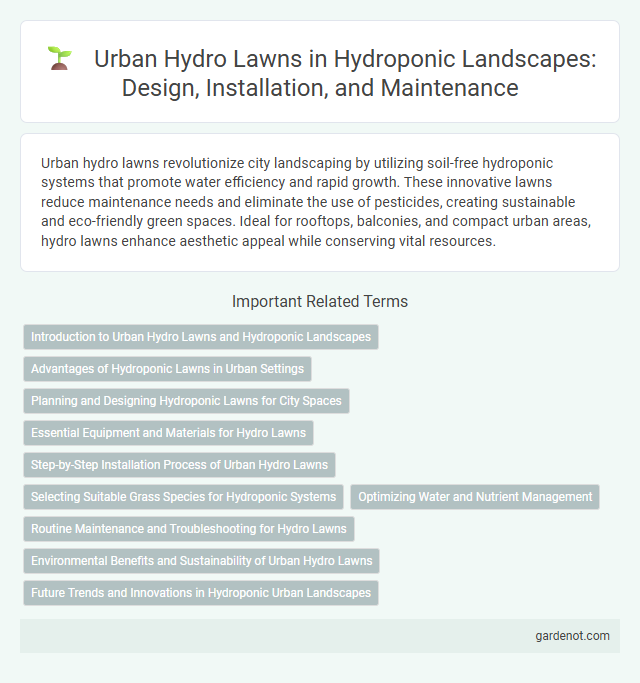Urban hydro lawns revolutionize city landscaping by utilizing soil-free hydroponic systems that promote water efficiency and rapid growth. These innovative lawns reduce maintenance needs and eliminate the use of pesticides, creating sustainable and eco-friendly green spaces. Ideal for rooftops, balconies, and compact urban areas, hydro lawns enhance aesthetic appeal while conserving vital resources.
Introduction to Urban Hydro Lawns and Hydroponic Landscapes
Urban hydro lawns utilize hydroponic technology to cultivate grass and plants without soil, promoting sustainable greenery in city environments. These landscapes optimize water usage through nutrient-rich solutions, reducing resource consumption compared to traditional lawns. Hydroponic landscapes enhance urban aesthetics while improving air quality and reducing urban heat islands.
Advantages of Hydroponic Lawns in Urban Settings
Hydroponic lawns in urban settings offer significant water savings by using up to 90% less water compared to traditional soil lawns, making them ideal for drought-prone cities. These soil-free systems reduce the need for harmful pesticides and fertilizers, promoting a healthier urban environment and minimizing chemical runoff. Rapid installation and low maintenance requirements enable urban planners to create green spaces efficiently, enhancing air quality and urban aesthetics.
Planning and Designing Hydroponic Lawns for City Spaces
Urban hydro lawns require precise planning to optimize limited city space and integrate efficient water circulation systems, promoting resource conservation. Designing these lawns involves selecting suitable hydroponic substrates and drought-resistant plant species that thrive in urban microclimates. Incorporating modular, vertical, or green wall configurations maximizes spatial utility while enhancing air quality and urban biodiversity.
Essential Equipment and Materials for Hydro Lawns
Essential equipment for urban hydro lawns includes a nutrient delivery system, such as drip emitters or sprinklers, to ensure precise water and nutrient distribution. Key materials consist of a growing medium like coconut coir or perlite, which provide aeration and moisture retention without soil. Reliable sensors for monitoring pH and moisture levels are vital to maintain optimal plant health and promote sustainable urban greenery.
Step-by-Step Installation Process of Urban Hydro Lawns
Urban hydro lawns are installed by first preparing the site with a lightweight, nutrient-rich growing medium specifically designed for hydroponic systems, ensuring optimal water retention and root aeration. The next step involves carefully placing pre-grown hydroponic grass mats or seeding the medium with grass varieties suited for urban environments, such as Bermuda or Kentucky bluegrass, followed by setting up an efficient drip irrigation system to maintain consistent moisture levels. Regular monitoring of pH, nutrient concentration, and environmental conditions is essential to promote healthy growth and establish a sustainable, green urban hydro lawn.
Selecting Suitable Grass Species for Hydroponic Systems
Selecting suitable grass species for hydroponic urban lawns is critical to ensure optimal growth and sustainability. Grass varieties such as Bermuda, Ryegrass, and Fescue are well-adapted to hydroponic systems due to their rapid growth rates and resilience to nutrient fluctuations. Tailoring species selection based on light availability, temperature, and water pH enhances the efficiency and aesthetics of hydroponic landscapes in urban environments.
Optimizing Water and Nutrient Management
Urban hydro lawn systems maximize water efficiency by utilizing recirculating irrigation technology that reduces runoff and evaporation losses by up to 40%. Nutrient management is optimized through precise delivery of balanced hydroponic solutions tailored to turfgrass growth stages, improving nutrient uptake and minimizing waste. Advanced sensors and automated controls enable real-time monitoring of pH, EC, and moisture levels, ensuring optimal conditions for robust lawn development in urban environments.
Routine Maintenance and Troubleshooting for Hydro Lawns
Routine maintenance for urban hydro lawns involves regular monitoring of water pH levels, nutrient balance, and sensor functionality to ensure optimal plant health. Troubleshooting common issues requires addressing algae growth, nutrient deficiencies, and irrigation system blockages promptly to prevent plant stress and foliage damage. Consistent inspection of pumps and filtration units enhances system efficiency and sustains lush, vibrant hydroponic turf in urban landscapes.
Environmental Benefits and Sustainability of Urban Hydro Lawns
Urban hydro lawns significantly reduce water consumption compared to traditional soil-based lawns, optimizing irrigation efficiency through recirculating hydroponic systems. These systems minimize chemical runoff and soil erosion, contributing to improved urban water quality and reduced environmental pollution. Integrating urban hydro lawns supports sustainable cityscapes by promoting biodiversity and lowering urban heat islands, enhancing overall ecosystem resilience.
Future Trends and Innovations in Hydroponic Urban Landscapes
Urban hydro lawns are advancing with innovations like smart irrigation systems integrating IoT sensors to optimize water usage and nutrient delivery. Vertical hydroponic gardens enhance green space efficiency, enabling lush landscapes in limited urban areas. Emerging trends include biodegradable growth media and AI-driven plant health monitoring, promoting sustainability and reducing maintenance costs.
Urban hydro lawn Infographic

 gardenot.com
gardenot.com